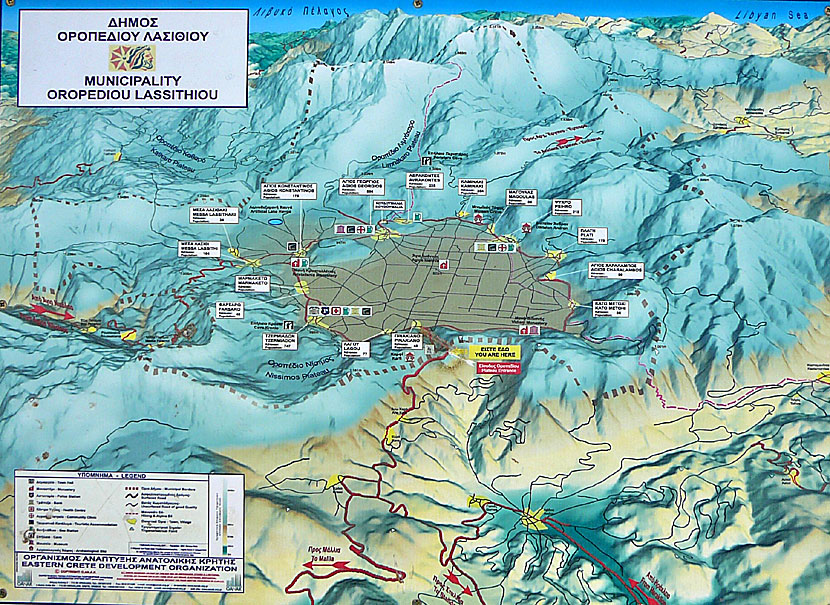
 |
| ISLANDS A-Z | CRETE | CYCLADES | DODECANESE | EASTERN AEGEAN |
| IONIAN | SARONIC | SPORADES | MAINLAND | ABOUT US |
The Lasithi Plateau in eastern Crete |
|
The Lasithi Plateau is one of the most beautiful places in all of Crete and something you just have to see and experience. There are two roads to the plateau, one from the south (Hersonissos) and one from the east (Neapoli).
View of Lasithi Plateau from Dikteon Cave.
The way up alone is worth the whole trip. It is so beautiful! If you come from the south, you pass the villages of Kato Kera and Ano Kera, just after that there is a viewpoint that is 803 meters above sea level. There is a museum there that somewhat modestly calls itself the Homo Sapiens Museum.
The villages of Kato Kera and Pano Kera along the road to the Lasithi Plateau in Crete.
This is what the road looks like when you get up to the Homo Sapiens Museum.
From the Homo Sapiens Museum, it is only 1 km to the southern entrance of the Lasithi Plateau. Leaving the mountains and driving down into the valley is an incredibly cool experience. The landscape you encounter is flat and it's almost like you think it's not real.
 Map of the Lasithi Plateau. |
|
When we came up to the Lasithi Plateau for the first time, we first got lost. We had intended to stay in the village of Agios Georgios, but when we got there we regretted it and drove to Tzermiado which we liked better. Tzermiado looked rough at first, but felt better after a while.. We have never seen so much simple Greek everyday life in such a short time. Old men and women everywhere. I could have photographed as much as I wanted, if only I had dared.
Agios Georgios is one of the larger villages on the Lasithi Plateau.
Tzermiado is my favorite village on the Lasithi Plateau.
The entire plateau, which lies at an altitude of approximately 840 meters and has an area of approximately 25 km2, is surrounded by mountains, and it is this setting that makes the landscape so spectacular. Almost the entire plateau is covered in crops, mainly potatoes, vegetables, fruit and almonds.
Cultivations on the Lasithi Plateau. The village of Tzermiado in the background.
What a difference there is in the vegetables that grow here compared to those that grow back home. For a vegetarian, it must be like coming to the Garden of Eden. Even for those who eat meat, Lasithi is a paradise. Broccoli are as big as basketballs and you want nothing more than to sink your teeth into them. |
|
Around the plateau there are many small windmills and it is these, among other things, that make the Lasithi Plateau so unique. The windmills are used to pump up water to the plantations. There used to be as many as 10,000 windmills here, today there aren't that many at all, and of those that remain, few are in use
Some of the windmills that remain on the Lasithi Plateau.
Old photograph of thousands of windmills as it used to look.
There are about twenty villages in the valley. Most, if not all, are quite worn, and very Greek. Perhaps it is not so strange that they are Greek since we are in Greece. But when compared with, for example, Hersonissos and Malia, the villages on the Lasithi Plateau are synonymous with what we usually call the real Greece. I don't think I've ever seen so many old ladies and old men as here. The largest village is Tzermiado and the second largest is Agios Georgios.
On the Lasithi Plateau, time has stood still, as this picture may symbolize.
As this picture may also symbolize. |
|
The Lasithi Plateau is surrounded by high mountains.
There are many excursion buses to the Lasithi Plateau every day. Most people go here to see Zeus' cave Dikteon Cave, and to shop for handicraft products, mainly textiles, but also other locally produced handicrafts, such as Cretan walking sticks. Dikteon Cave is the main attraction on the Lasithi Plateau, and is the main reason why tourists come here.
Read about Dikteon Cave here »
Real crafts from Crete can be bought in small villages, like here in Tzermiado.
If you are looking for Cretan hiking sticks, you will love the Lasithi Plateau.
ACCOMMODATION ON THE LASITHI PLATEAUI can highly recommend staying a night on the Lasithi Plateau. It is an experience of rank. Getting up early in the morning and seeing the dewy valley come to life becomes a memory of a lifetime. I promise. Be prepared for low temperatures. When we were here one morning it was only 10 plus degrees outside. Maison Kronio is one of the few hotels on the plateau, Argoulias is also very good. Both are located in Tzermiado. Book Maison Kronio here »Book Argoulias here »
Two other interesting plateaus in Crete are the Katharo plateau and the Nida plateau. |
WHAT YOU MUST NOT MISS WHEN YOU VISIT THE LASITHI PLATEAU |
HOME |
ABOUT US |
SEARCH |
BOOK HOTEL |
GREEK ISLANDS |
SWEDISH
|
|
© 2007-2025 | Janni Eklund | Kalispera and Kalimera. |